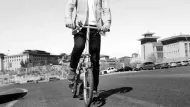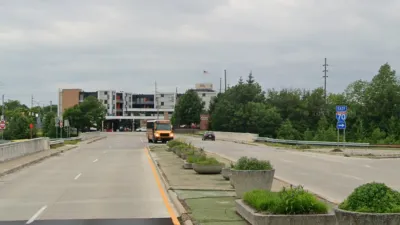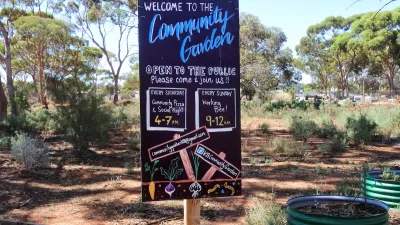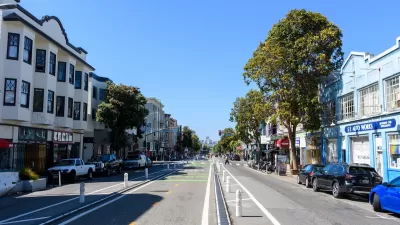The second and final post about MoMa's exhibit, "Uneven Growth: Tactical Urbanisms for Expanding Megacities."

In part one of this two-part blog post I asserted that an uncounted number of projects are being carried out globally under the banner of Tactical Urbanism. I also questioned whether Tactical Urbanism should be hailed as a solution to the complexity of global inequality and asked what role elite institutions might play in combating unevenness. Finally, I offered a definition that serves as one lens through which the Museum of Modern Art’s Uneven Growth: Tactical Urbanisms for Expanding Megacities exhibit may be observed.
MoMA’s introduction to Uneven Growth, and the essays penned by academic heavyweights like Saskia Sassen and David Harvey for the companion publication, shed much light on the systemic failures of conventional city planning. For those not willing to wade through academic prose laced with designer-speak ("territorial fragments," anyone?), I offer curator Pedro Gadanho’s succinct summary:
“As the world shifts toward a large majority of urban population, and as recent global economic crises call into question traditional modes of planning cities, different narratives and design tactics are urgently needed to address new urban conditions.”
Yes! Spot on. And in Uneven Growth "Tactical Urbanisms" are positioned as the tool du jour for addressing inequality in Mumbai, Hong Kong, New York City, Lagos, Rio de Janeiro, and Istanbul.
Worth noting is Gadanho’s insistence on the plural (urbanisms). It's an intentional, if not clever technique that gave the design teams more latitude in the interpretation and application of Tactical Urbanism. This could have been a good thing. However, after reviewing the show and speaking to a participant, it seems few designers knew about Tactical Urbanism's key principles. Thus, no one should expect the six featured submissions to show off the actual application of low-cost, temporary, and scalable projects. That's too bad. Many of the proposals would have benefitted from some real-world testing and the documentation of what actually worked and didn't would have made the show far more engaging.
There is a substantial amount of visible discord found across the exhibit, including within the six submissions, each one created by two otherwise unaffiliated organizations who were paired together. According to Gadanho, this approach was done to create "productive conflict." Such conflicts can be healthy but in this instance they resulted in a strange mixture of proposals that at times seem unrelated in scale and applicability.
Of course the exhibit didn't have to be structured this way. Amongst the featured projects found within the pages of the Uneven Growth publication are numerous project examples that align closely with the definition I put forth in part one of this blog post. Additionally, the Uneven Growth website includes an ever-growing and inspiring collection of built projects sourced from six continents. In my opinion, this is Uneven Growth's best contribution. Why the exhibit is bifurcated in this manner is not really explained.
On a positive note, the design teams utilized a great mix of media to not only define the issue(s) of choice, but to also communicate their proposals. As pieces of art, each can be thought-provoking and are at home on the white walls of a modern art museum. One onlooker called it a "visual assault," and I think she meant that in a good way?
One of the strongest parts of the exhibit is the well-timed mini-documentary summarizing New York City’s acute affordable housing shortage. The video does Uneven Growth a great service by clearly defining a host of issues that are adversely impacting New York. Similarly, a collection of axonometric drawings not only show how apartment units are being subdivided illegally, but invoke immigrant housing conditions long thought to be part of the city's storied past, not its present and near future.
Less clear is how the proposed policy vehicles—creating Housing Cooperative Trusts and Community Growth Corporations—actually make use of Tactical Urbanism as a scalable changemaking tool. That is not to denigrate the ideas contained therein—New York City needs to rethink its housing policy and the proposals at least offer a skeletal framework—but to assert that the prescriptions are a far cry from the city’s past and current approach. The two teams could have also offered proposals or action, tactical demonstration projects that could raise awareness for their policy ideas. This approach, relying on action to move policy, rather than the reverse, is a well-known and effective tool used by Tactical Urbanists.
Another proposal worth ogling is the beautiful, complex, and color-soaked maps and renderings of a future Lagos. The tripartite proposal focuses on energy supply, water, and transportation. The issues surrounding each were supposedly derived from a series of mapping exercises resulting in the formulation of "prototypes" at two different scales: "urban visions at a large scale" and "elemental interventions" at a smaller scale. In general, the prototypes are described as tools for supporting and enhancing the city's omnipresent "informal activity," a term that seems almost meaningless given the context. In a place like Lagos one could probably just call it "activity," no?
The use of prototypes is intriguing though. Tactical Urbanists apply this method to test ideas frequently, and to get buy-in from community and city leaders, investors, and other change agents. But that was not really the approach here. Instead, proposals for "shimmering solar panel roofs, wind turbines, biomass sources, and clean energy" come off as aloof and disconnected from the population they allegedly serve. How do poor people access the resources to build and maintain such expensive technologies? Thus, it’s difficult to understand what distinguishes these "prototypes" from the actual thing the designers seek to insert into the city’s fabric.
To be fair, a few of the small-scale transportation and public space proposals—street vendor and bicycle repair stations, and bus stops enhancements —could be realized as low-cost prototypes. Why the design team didn't develop them beyond drawings might be answered in a number of ways, but have the people of Lagos not developed responses to these needs already? If so, documenting these very real, small-scale improvements would have been fascinating.
Finally, how the the large-scale "visions" for Lagos come to fruition is beyond left up to our imagination; ring roads, canals, cable cars, and a light rail system may or may not be needed in Lagos, but the delivery of these large infrastructure investments cannot and should not rely on tactical interventions alone. And, they definitely shouldn't be called "prototypes."
These two projects comprise only part of the exhibit, but it's clear that all six teams spent a great deal of time developing their ideas and were probably paid very little to do so. Unfortunately, this doesn't change the fact that most followers of the Tactical Urbanism movement will find only traces of the core principles within Uneven Growth.
For example, how the reclamation of land in Hong Kong Bay for themed islands (including the "island of pleasure"), or the retrofitting of Istanbul’s Corbusien residential tower blocks translate into realistic improvements for the people the exhibit purportedly aids is difficult to ascertain. But, that's not really the point. When asked if the six projects on view are implementable, Gadanho simply replied, "they are not."
Not to discourage "blue sky thinking," which does have an important role to play in pushing discussion, but the curatorial team's cynical approach suggests that the exhibit deserves a different title. The critiques printed in New York magazine, Landscape Architecture Magazine, and other publications are warranted for no other reason than the exhibit fails to connect visionary ideas with what's possible now. This is the very essence of Tactical Urbanism.
Moreover, Uneven Growth's proposed "design solutions for future urban developments," as described by Gadanho, come from the mindset that 'solutioneering' is a desired approach. Do we not have a century of history showing that we planners often create as many problems as we think we solve? The profession should stop obsessing about solutions and focus instead on a new project delivery framework that allows more agile and distributed responses to emerge instead. This approach is consistent with the exhibit's call-to-arms, but more importantly places an emphasis on a more resilient approach to city-design that recognizes planners, government leaders, or museums don't always have all of the answers.
To conclude, my personal experience researching and practicing Tactical Urbanism is largely within cities and towns of developed, relatively wealthy nations. At a political level, the burden is not having too little, but too much. Today, this excess comes in the form of too many outdated practices, policies, and project delivery systems developed for issues of another era. In these places, Tactical Urbanism has arisen from different circumstances than in places like Mumbai. But no matter the location, all applications of Tactical Urbanism have in common the human impulse to make life easier through neighborhood-scale projects. What we've learned is that government leaders or hired professionals do not always lead the way and the more and more people are looking to co-create their surroundings. This explains why so many small-scale and peer-to-peer actions continue to gain such currency in cities around the globe. The initial steps in this process -- the application of Tactical Urbanism -- may seem prosaic to some, but have proven to collectively inspire long-term urban transformation.
That said, Tactical Urbanism is not a or even the solution to [__Insert urban problem here__]. It alone will not build public transit systems in Lagos, deliver affordable housing in New York, or create brand new islands in Hong Kong Bay. What Tactical Urbanism can do is get planners and designers out of city hall, design studios, and museums, and back into the streets where the foundation for social, political, and economic capital is built. It can also cut through bureaucracy and break big plans down into manageable projects using many, many small actions that test concepts with quick feedback loops.
If we — city leaders, citizens, private sector, and advocates — can’t work together at the small scale, we'll certainly have a hard time responding effectively to the larger economic, social, or environmental challenges MoMA's Uneven Growth wants to solve.

Planetizen Federal Action Tracker
A weekly monitor of how Trump’s orders and actions are impacting planners and planning in America.

Congressman Proposes Bill to Rename DC Metro “Trump Train”
The Make Autorail Great Again Act would withhold federal funding to the system until the Washington Metropolitan Area Transit Authority (WMATA), rebrands as the Washington Metropolitan Authority for Greater Access (WMAGA).

The Simple Legislative Tool Transforming Vacant Downtowns
In California, Michigan and Georgia, an easy win is bringing dollars — and delight — back to city centers.

The States Losing Rural Delivery Rooms at an Alarming Pace
In some states, as few as 9% of rural hospitals still deliver babies. As a result, rising pre-term births, no adequate pre-term care and "harrowing" close calls are a growing reality.

The Small South Asian Republic Going all in on EVs
Thanks to one simple policy change less than five years ago, 65% of new cars in this Himalayan country are now electric.

DC Backpedals on Bike Lane Protection, Swaps Barriers for Paint
Citing aesthetic concerns, the city is removing the concrete barriers and flexposts that once separated Arizona Avenue cyclists from motor vehicles.
Urban Design for Planners 1: Software Tools
This six-course series explores essential urban design concepts using open source software and equips planners with the tools they need to participate fully in the urban design process.
Planning for Universal Design
Learn the tools for implementing Universal Design in planning regulations.
Smith Gee Studio
City of Charlotte
City of Camden Redevelopment Agency
City of Astoria
Transportation Research & Education Center (TREC) at Portland State University
US High Speed Rail Association
City of Camden Redevelopment Agency
Municipality of Princeton (NJ)






























